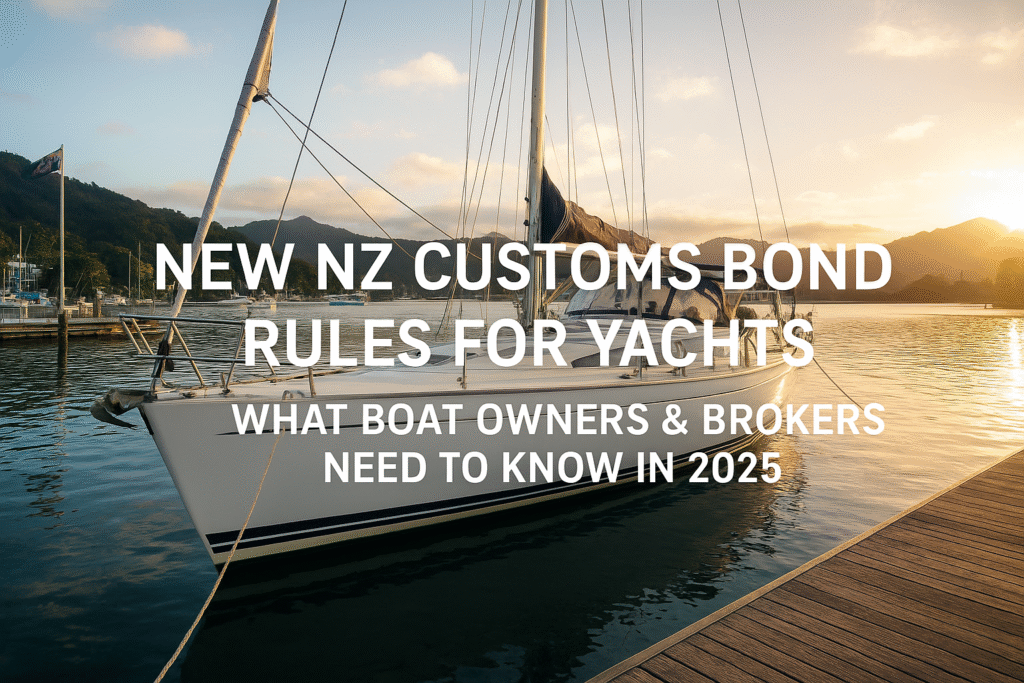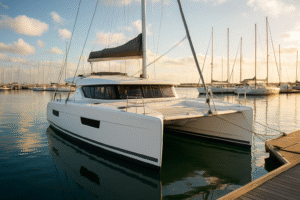
New NZ Customs Bond Rules for Yachts: What Boat Owners & Brokers Need to Know in 2025
Table of Contents
ToggleThere’s been a quiet but significant shift in New Zealand Customs policy — and it’s already making waves through the yacht and brokerage community.
If you’re an international cruiser, a NZ resident with a foreign-flagged vessel, or a broker working with imported boats, this new rule could change how (and when) you can list a boat for sale in Aotearoa.
Let’s unpack what’s changed, who it affects, and what you can do about it.
🧭 What’s Changing at New Zealand Customs
Until recently, many visiting yachts entered NZ under a Temporary Import Entry (TIE) arrangement — a status allowing foreign boats to stay in NZ waters without paying full GST or import duty, provided they weren’t permanently imported or sold locally.
That’s now changing. According to New Zealand Customs, any vessel under a TIE (or owned by a NZ resident with tax unpaid) must now pay a security bond equivalent to the full GST and duty on the boat’s value before it can be listed for sale in NZ.
Essentially, even if you intend to export the yacht later, you’ll need to lodge funds covering the tax liability up front.
The goal, according to Customs, is to ensure that all boats marketed or sold locally have their tax obligations secured — a move designed to close previous loopholes.
⚓ Who This Affects
International cruisers bringing yachts into NZ who hope to sell locally before sailing on.
New Zealand residents with boats imported under temporary or foreign registration who wish to list for sale.
Brokers, refit yards, and marine service providers who rely on a steady flow of imported yachts entering the NZ market.
If you fit any of those groups, these changes could significantly impact your timing, capital, and compliance obligations.
💰 The Financial & Operational Impacts
1. Bond Requirements Mean Cash Tied Up
Before listing, you’ll need to secure a bond matching full GST (15%) + duty (typically 5%) on your yacht’s assessed value. That could easily amount to tens or hundreds of thousands of dollars — funds you won’t have access to until the sale or export is complete.
2. Slower Listings
The bond approval process through Customs can take time. Until approval is granted, your vessel cannot be legally marketed or listed.
3. Reduced Imported Inventory
This rule may discourage some offshore sellers from bringing their yachts to NZ — reducing the supply of late-model imports available locally.
4. Flow-On Effects to NZ Marine Businesses
As NZ Marine Industry Association members have noted, the reduced influx of foreign boats could mean fewer refits, fewer broker listings, and less yard work overall.
🧾 How to Stay Compliant (and Stay Ahead)
Here’s how boat owners, brokers, and delivery skippers can adapt:
Confirm your vessel’s import status
Check whether you’re under TIE or have fully imported status. The difference is crucial.Get a professional valuation
Customs will require an accurate market value to determine your GST/duty exposure. Use a certified marine valuer or trusted broker.Plan ahead for the bond
Apply early, especially if your boat is arriving soon or you’re scheduling a delivery.Work with a knowledgeable customs broker
Maritime law specialists, such as those highlighted in this analysis by Maritime Law NZ, can help structure your import correctly.Update your sales contracts
Make sure sale agreements reflect who is responsible for paying or reclaiming the bond.Educate your buyers
Buyers unfamiliar with NZ’s system may not understand why a bond exists — transparency will smooth transactions.
🧭 Why Customs Is Doing This
From Customs’ perspective, this change:
Ensures all yacht sales occurring in NZ waters are tax-compliant.
Creates a level playing field with domestically imported boats.
Reduces the chance that vessels listed “for export” are quietly sold locally tax-free.
While those goals are understandable, it may come at the cost of discouraging visiting yachts from engaging with NZ’s strong marine economy.
🚤 How Yacht Delivery Solutions Fits In
At Yacht Delivery Solutions, we’re used to helping owners navigate not just the Tasman, but the maze of NZ regulations too.
If you’re planning to import or deliver a yacht to New Zealand for sale, here’s how we can assist:
Customs coordination: We’ll work with your broker or agent to ensure arrival paperwork and status are correct.
Pre-delivery prep: Making sure your vessel meets MetService Marine weather windows and biosecurity requirements.

Local knowledge: We know which ports (Auckland, Opua, Tauranga, Nelson, Lyttelton) handle imports smoothly — and which can be trickier under new rules.
Professional advice: We stay updated on Customs and MPI policy shifts to keep your delivery legal, efficient, and stress-free.
🌊 Final Thoughts
This new bond requirement might look like a small paperwork change, but its ripple effect could be felt across the NZ marine economy.
For brokers, it means fewer quick imports. For international owners, it’s a higher bar to list their yachts. For service providers, it may mean fewer refits and commissions.
Still, with the right planning — and an experienced team like Yacht Delivery Solutions NZ guiding your import and delivery — it’s entirely manageable.
Our advice? Plan early, budget for the bond, and get expert help before your yacht ever hits NZ waters.
⚓ Whether you’re bringing in a bluewater cruiser from Fiji or delivering a performance yacht from Sydney, we can make sure your vessel arrives, complies, and is ready for sale — the right way.
📞 Contact Yacht Delivery Solutions NZ to discuss your delivery or import plan today.


Leave a reply